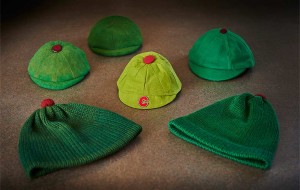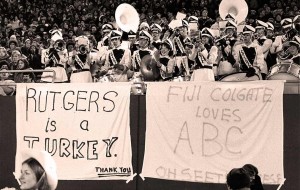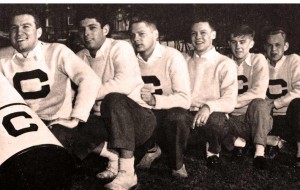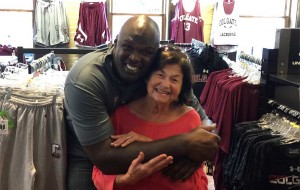More folklore
Great story in the Scene on the mysteries of Colgate (“Colgate Folklore, Facts & Falsehoods“). I had never heard of most of them. I can add two:
- 1. There was a story from the ’30s or ’40s, when Colgate was playing Syracuse in football. We were told that one year, Syracuse fans hired a small plane, and the morning of the game, they dive-bombed Taylor Lake and dropped bags with food coloring that dyed the lake orange!
- 2. When I attended, 1971–1975, there was a rumor going around that Columbia was considering dropping its undergrad program to become the first grad-only school. So they would only have the famous school of journalism, law school, business school, med school, etc. The idea was then that Colgate would enter the Ivy League as a ninth school, and be the eighth school for all sports.
Doug Rebert ’75
Hillsborough, Calif.
In Case of an attack
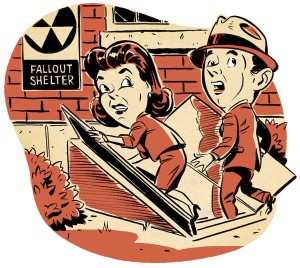
An addition to the item on the Newell Apartments bomb shelter status (“Colgate Folklore, Facts & Falsehoods“). My father was one of the village civil defense program coordinators. (I still remember the training for Geiger counters taking place in our dining room with other village residents.) Anyway, the shelter we were instructed to go to in case of an attack was the basement of Case Library; we lived on Hamilton Street.
A number of years later, spring term 1971, while attending an art history class in the Jerome Room in the Case basement, the classroom rear door was open to the basement hall. Lined down the hall were piled Civil Defense (CD) barrels of potable water and food stuffs. The CD signs were also still on the hallway walls. I expect you could probably find some of the old buildings and grounds people who eventually had to carry the supplies away for disposal.
Cal Crouch ’78
Hamilton, N.Y.
Not a green bean(ie)
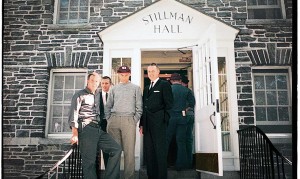
Greetings. In the autumn 2015 Scene (“Colgate Folklore, Facts & Falsehoods), you say freshmen wore green beanies until the 1960s. Not true. They were maroon. I have pictures of myself and friends as freshmen in the fall of 1959.
Richard Andrews ’63
Perrysburg, Ohio
Under the subject of 3 F’s (“Colgate Folklore, Facts & Falsehoods,), it says it is true that up until the 1960s, the freshmen had to wear green beanies. If my memory serves me correctly, our class (1956) wore maroon beanies, not green, so that fact is partially true. I’m even pretty sure that a few of my classmates still have their maroon lids. I recall we had to wear them for the entire first semester unless, for some strange reason, we managed to beat Syracuse in football. We wore ours all first term! We also had to wear narrow black ties along with the beanie, which really made for some weird fashion statements. Also, I think the classes after us had maroon beanies, not the green. I had never heard of the green ones before I read the Scene article, but I’m glad we had the maroon ones.
Jerry Rhodes ’56
Cary, N.C.
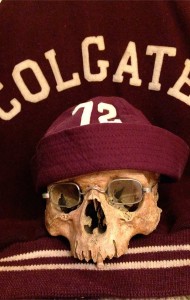
Enjoyed your article “Colgate Folklore, Facts & Falsehoods” in the autumn Scene. I’m writing to add detail to the note on beanies. I did not know the beanies used to be green. In any case, I believe my class (1972) was the last to wear beanies. I don’t know about previous years, but our freshman year, 1968, the beanies were maroon, sailor-style (no brim, unlike the one illustrated), with the class year in white numerals. I include a photo of mine (“The Last Beanie”). We were told that in previous years the beanies were mandatory for freshmen, but that for us they would be optional. They were available at the bookstore. A very few of us in East Hall opted to buy and wear the beanies. But it was, after all, the late ’60s, and most chose not to observe that quaint tradition.
Jay Dunbar ’72
Chapel Hill, N.C.
Addendum from the archives
The beanies started out green and became maroon around 1952–53. The student handbook from 1952–53 refers to maroon beanies. The next earliest handbook we have is 1949–50, and that still refers to green beanies. A few articles in the student newspaper confirm this. An article from 1951 refers to green beanies, and a 1952 article to maroon. Finally, another article reports that green beanies were required as late as 1968.
Let’s talk turkey
The title of the photo of the Colgate pep band in your autumn 2015 issue (“Homecoming of yore,”) reads “circa 1962.” Thought you’d like to have the details on this unusual photo. This photo was taken Nov. 25, 1976, at Giants Stadium when Colgate lost to Rutgers 17–9 in a controversial game marred by a bizarre penalty against the Raiders that was later noted by the official who made it to be an incorrect call. Colgate was leading 6–3 at the time of this play and might have won the game, in so doing, defeating an unbeaten, nationally ranked Rutgers squad.
The sign saying “Fiji Colgate Loves ABC” was there because this game was televised regionally by ABC — the first time Colgate football had ever been televised by a national network. The other sign that reads “Rutgers is a turkey” was placed because the game was played on Thanksgiving — moved from its original scheduled date of November 20 due to the interest in televising it and because Rutgers found they could sell more than 32,000 tickets to the game by moving it from its campus site to the Meadowlands [East Rutherford, N.J.].
Al Yellon ’78
Chicago, Ill.
In the picture
Editorial note: Don Trischett ’49, Saint Augustine, Fla., contacted us to correct the date we used (1932) for this photo of the cheer team in “Homecoming of yore,” autumn 2015 Scene. “My memory is a little foggy, but as I remember, that photo was taken either in the fall of 1944 (freshman year) or fall of 1946 when I returned to school after my discharge from the U.S. Navy,” said Trischett, who was head song leader 1946–48. He is pictured second from left.
Bonding with alumni athletes
Carmen, my wife of 50 years, and I went up to Hamilton for the homecoming Colgate-Yale game. On that weekend, the All-Americans Adonal Foyle ’98 and Jamaal Branch ’05 were each being honored. Prior to the game, I watched the teams warm up from the stadium. Branch and his wife, Melanie ’05, parked themselves next to me. I recognized Branch and we had a great 20- to 30-minute conversation regarding Colgate football, his profession, and life in general. He autographed my program, and his wife and I exchanged cards.
My wife, as is her wont, avoided the game and went to the bookstore. Of course, Mr. Foyle was there. They struck up a conversation, and Carmen and Adonal ended up in a big bear hug, which was photographed for posterity.
Colgate is unique. Where else could a husband and wife by chance meet two iconic athletes who conversed with us as Colgate friends, without any airs or phoniness?
Despite the loss to Yale, it was a great homecoming!
Michael DeMarrais ’62
Woodcliff Lake, N.J.
She helped make a Scene
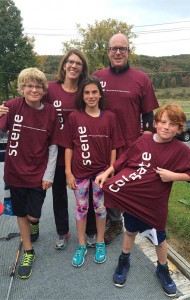
After Molly Baker ’91 penned the travel tips column “Maroon’d in Harbor Springs, Mich.,” for the autumn 2015 issue, she visited Colgate with her family. Molly and husband Josh co-directed Colgate’s Outdoor Education Program for 12 years, so they came to show their kids the campus, the house they built here, Basecamp, and then the Adirondacks.
Be part of the story
The Scene is planning an article featuring humorous stories about professors. Do you have a funny memory about a particular professor — something that happened during class or a characteristic for which he or she was well known? (Your submissions need to be publishable and not embarrass the professor.) We also want to know why this person had a positive impact on you. Send your stories to Managing Editor Aleta Mayne, amayne@colgate.edu, or Colgate Scene, attention: Aleta Mayne, 13 Oak Drive, Hamilton, NY 13346.


